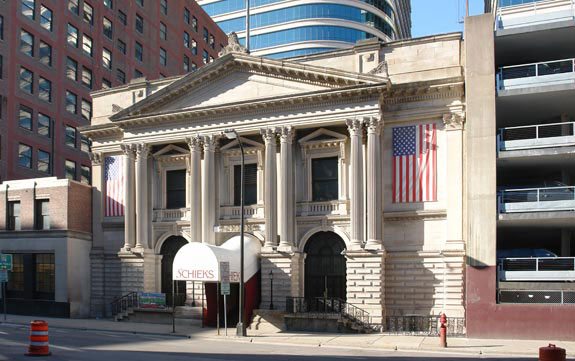Schiek’s Cafe
Minneapolis
Schiek’s Cafe had a long history in Minneapolis.
FRED SCHIEK
Berliner Beer Halle: 122 Hennepin Ave.: 1887
Schiek’s was started by and named for Frederick Schiek, who was born in Sinshein, Baden Germany in about 1836. He emigrated to New York City, where he lived from 1852 to 1858, and then to a farm outside of Lansing, Iowa, in 1859. In 1862 to 1887 he was a merchant in Lansing, and then to Minneapolis in 1887.
His obituary said that in his early business career he managed the old Berliner Beer Hall at 122 Hennepin Ave., which was across the street from City Hall and owned by Louis Brandt. Permit cards show that this building was extant in 1887, and was a saloon in 1891. It was also a hotel and a mission. This building was recently replaced by an apartment building in 2017.
An article about a court case in the Minneapolis Tribune dated March 11, 1893, indicates that Schiek operated a saloon at the corner of Washington and First Avenues, and may have done so for at least five years. Thus, the year 1887 would seem to be in order. He was in a lawsuit against Brandt about renewing a five year lease.
It was still the Berliner Halle Saloon in October 1901. Brandt was running it.
Importer: 49 Washington Ave. So.: 1887 to 1894
Schiek also had a wholesale liquor house 49 Washington Ave. So., apparently while he was working at the Berliner. The first hit in the Star/Tribune database for Frederick Schiek was on December 28, 1888, when he was listed as a merchant in a list of other merchants. Ads placed in the Tribune in April 1890 call Schiek an importer of fine whiskeys and liquors, running his business from 49 Washington Ave. So. This does not appear to be a restaurant or a cafe, however. But the start of the Schiek’s name is often counted from this date.
THE BIRTH OF SCHIEK’S
45 and 47 Third Street So.: 1894 to 1961
Fred Schiek started his business at this location on June 30, 1894. Schiek bought the once famous Frank Shaw’s Columbia poolrooms. In 1883 there was a Frank Shaw who was a gambler who got in trouble for running a disorderly house, and an article from 1887 mentions that he and a partner ran a pool room. The building goes back to before 1884.
Schiek tore the building down to its foundation and built everything up out of mahogany. The bar was 40 feet long, consisting of five arches resting on six fluted columns with carved caps above. Even the cigar case and lighter were described in florid detail. There was a lunch counter with a dumbwaiter that ran downstairs where all the cooking was done. Ferns and flowers could be placed in against the wall. Five banquet rooms were available, in a modern style that could be combined into one big room. Schiek had a private office and a wine showroom, and a cold room in the basement to keep his stock. (Minneapolis Tribune, Saturday, June 30, 1894)
OLDEST CAFE
Schiek’s Cafe was often said to be the oldest restaurant in Minneapolis when it closed in 1971.
There were two years in contention for when it opened.
When it closed in 1971 the news article said it had been in business for 109 years, making the opening year 1862. This guess was apparently based on wine labels found in the basement bearing Fred Schiek’s name (as importer) and the 1862 date. The chronology says that Fred was in Iowa in 1862, so the labels could have come from there. Or it may have been aged wine?
But according to Minnesota Eats Out and the ad below from the program of the Norwegian Sangerfest (songfest), held in 1930, the year would be 1887.
Given the fact that Schiek was just the manager of the Berliner and it did not change its name, I think it would be fair to say that the actual Schiek’s started when Fred Schiek put his name on his own cafe in 1894, making the total run 77 years.
A one-line ad on October 6, 1894, says “Try a Lobster – A la Francaise, at the end of Fred Schiek Co.’s Shell Fish Buffet, 45 and 47 Third Street South.”
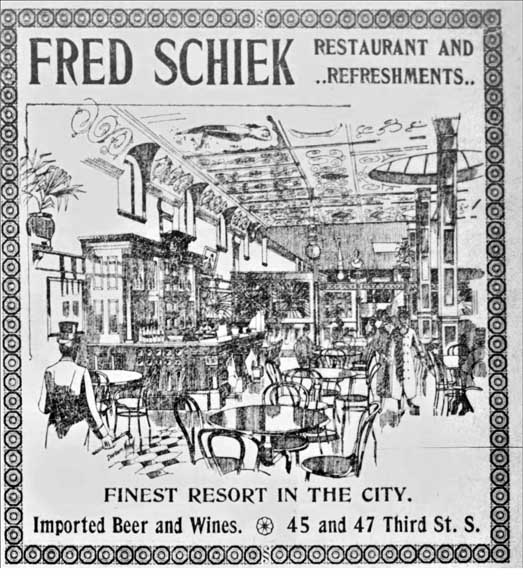
THE DEATH OF FRED SCHIEK
Fred Schiek died on April 8, 1904, after a protracted illness. Much was made of his desire to die on a Friday, and that he did. Operation of the restaurant went to his son, Louis, and his son-in-law, J.H. Heiser.
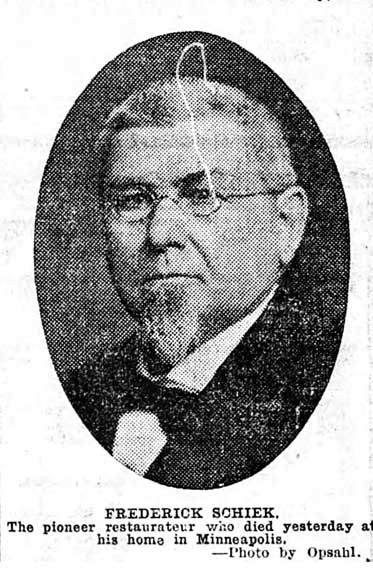
Elegant or no, Schiek’s was still a Saloon, no unaccompanied ladies welcome, no ladies approving.
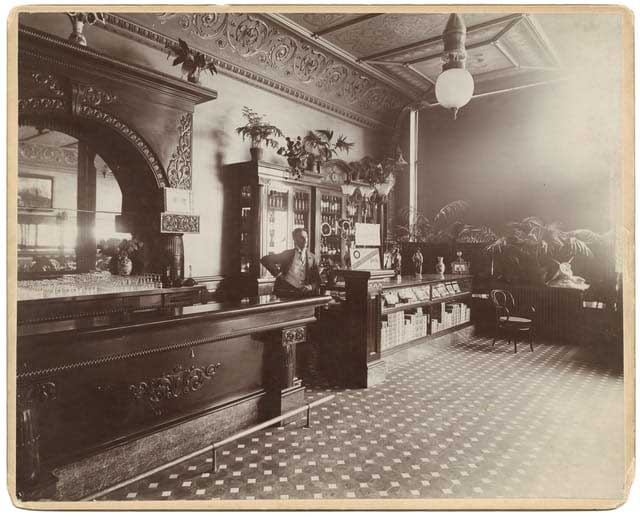
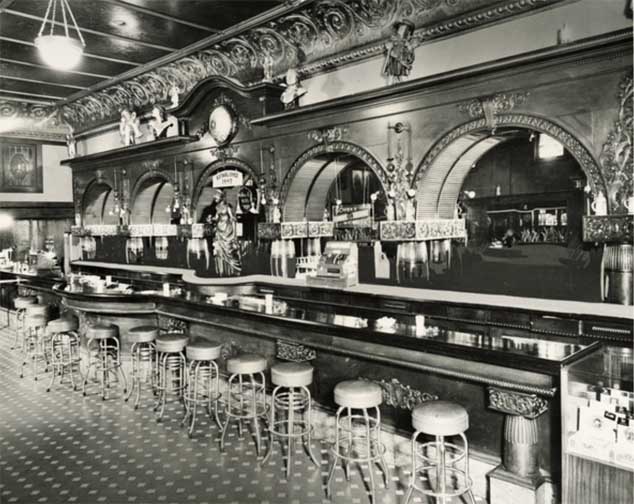
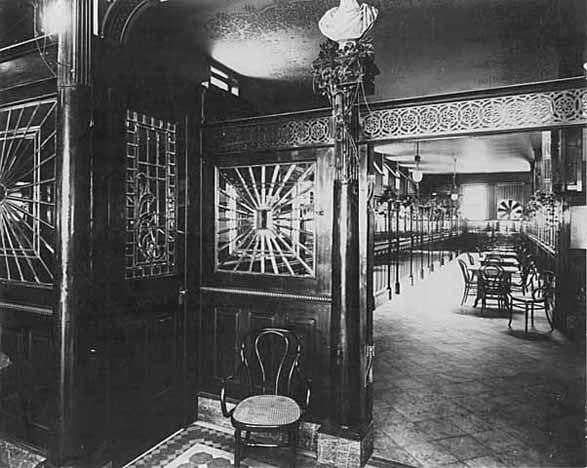
On July 22, 1908, the Tribune ran a story about prolific drinking Downtown, with flagrant violations of the law. Minneapolis may have been wet or dry during this pre-Prohibition year, but the drinking was certainly going on after closing time. Schiek’s was one of the places visited by the reporter, who cited drinking with no food served. The bartender closed the door at 2 am, but people could still get in through the back door. There were reportedly hundreds there – and this all happened on Wednesday, July 15, 1908.
In December 1911, Schiek’s began an advertising campaign, placed by the Fred Schiek Co. in large print.
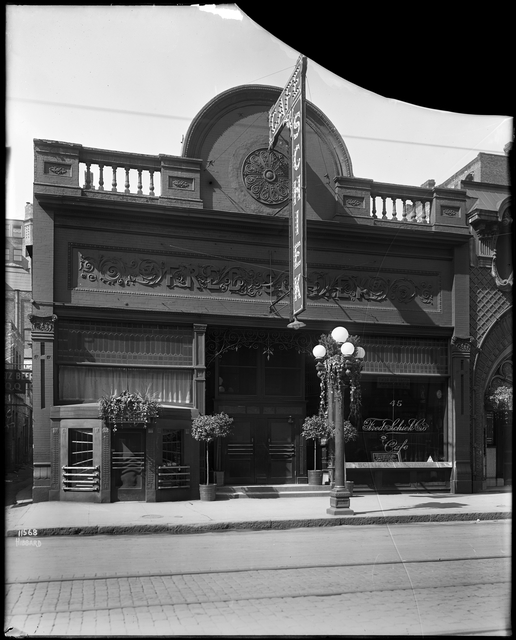
PROHIBITION
Although 1930 was a pure Prohibition year, the ad above promotes light and dark lager, which turns out to be a process to make beer, or in this case, near-beer, no doubt.
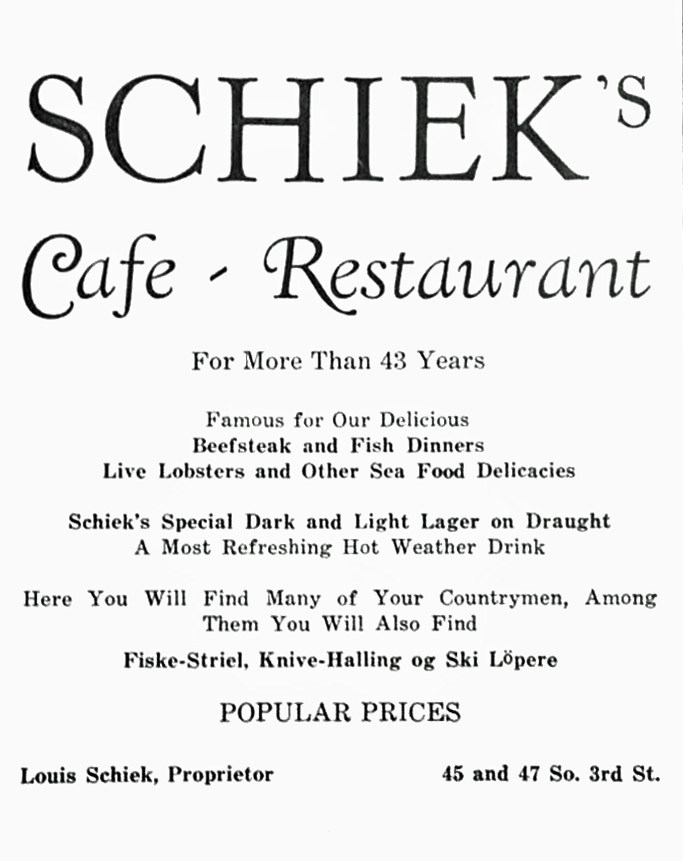
THE END OF PROHIBITION
Beer became categorized as “non-intoxicating” on April 7, 1933, and one of the iconic photos in Minneapolis history is this bartender (do we know his name?) handing out the suds at Schiek’s. This guy’s name has just got to be Harry.
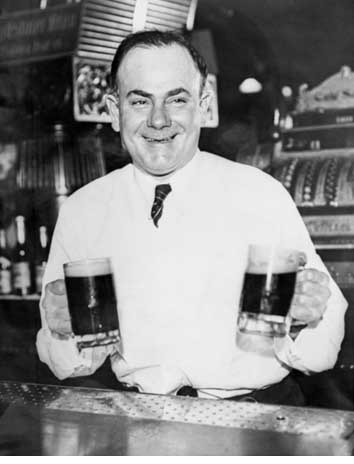
Here’s Harry again, no doubt with some politicians who want to take credit for the end of Prohibition. Doesn’t look like Harry is buying it.
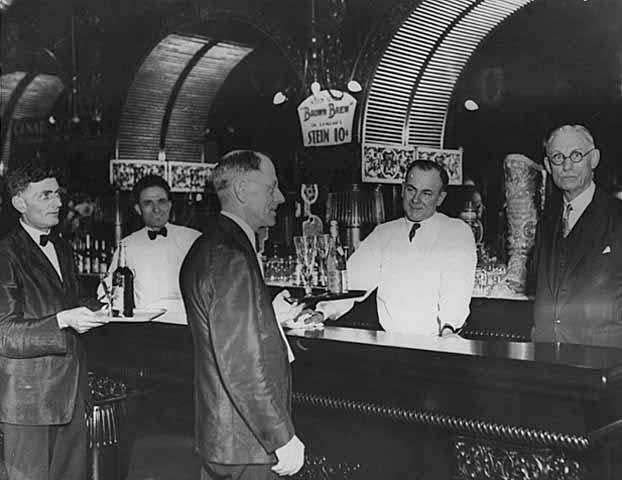
Louis Schiek expressed his concern about young people spiking their beer (and tavern owners facilitating thus) in an article in the Tribune dated March 23, 1933. He spoke of having to educate people how to behave in a high-class restaurant such as his. And he reiterated the opening date of June 30, 1894. He planned to have music, but not jazz – perhaps a string quartet.
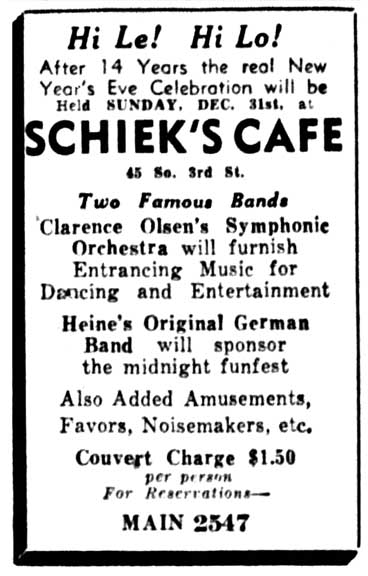
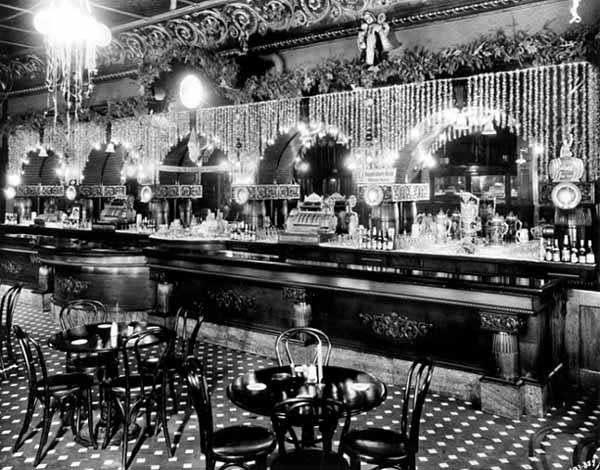
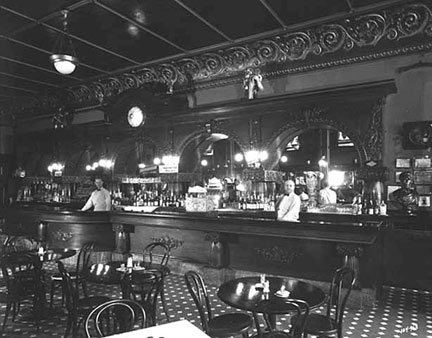
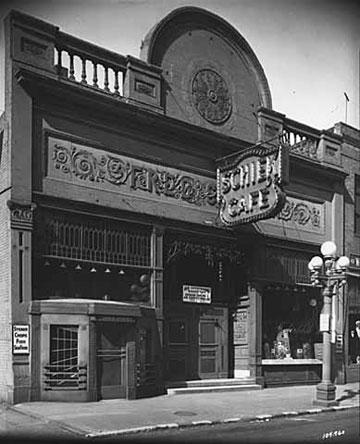
By November 1934, the Cafe was featuring Clarence Olson’s Trio, the Rhapsodion Trio, and Heinie’s German Band. Below, our host Louis promises Delightful Music with Soloists.
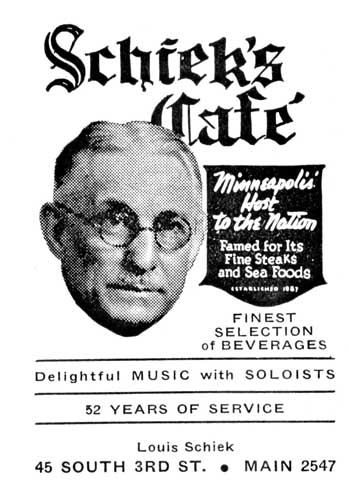
Apparently the Rhapsodians had grown by 1936:
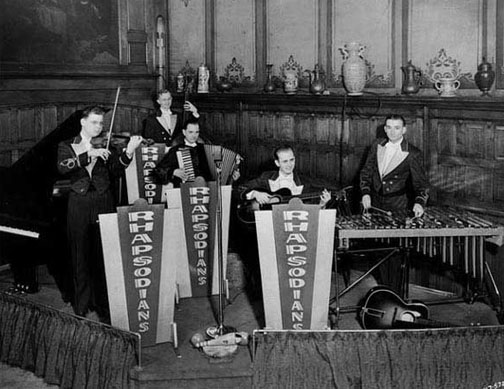
THE DEATH OF LOUIS SCHIEK
Louis Schiek died on July 10, 1941. Somehow the date 1887 was attached to the Cafe’s opening, when Fred Schiek was managing a saloon before he opened Schiek’s, and the legend continued.
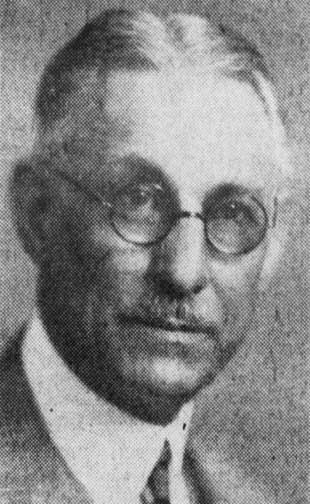
BEN BERGER
In 1944 the restaurant was purchased by three men for about $50,000. Benjamin N. Berger was the operator of a chain of theaters, and in 1947 he founded and owned the Minneapolis Lakers with Morris Chalfin. Berger owned it until the cafe closed in 1971. W.A. Steffes was the operator of the World Theater. Harry Williams was the manager of the restaurant, assisted by Wilfred (Rosy) Ryan, baseball figure.
In 1945, the three owners applied for permission to transform the cafe into a “swank cabaret restaurant” so that they could install cabaret-type shows. (Minneapolis Star, January 10, 1945) There was much trepidation about the new owners would do to this City Institution.
The building next door was acquired so that the kitchen would be on the same floor as the restaurant, and a new lounge was installed.
In 1946, Schiek’s made a settlement to the Federal Government of $795 for overcharging for meals. During this postwar period, to keep inflation down, the Office of Price Administration had a list of prices a business could charge, and fines were assessed for overcharging.
RETURN OF ENTERTAINMENT
Beginning on December 29, 1949, Schiek’s began presenting what was called “a series of capsule presentations of musical comedy tunes,” delivered by singers in costumes. Numbers from “Show Boat” made up the initial offering. The cast included Jean Traun, Norma Gilbertson, Beverly Hanson, Carl Fox, Bill Loomis, and Wayne Hartley. Music was under the direction of Bob Beaulieu, and the show was staged by Glyde Snyder. (Minneapolis Star, December 30, 1949)
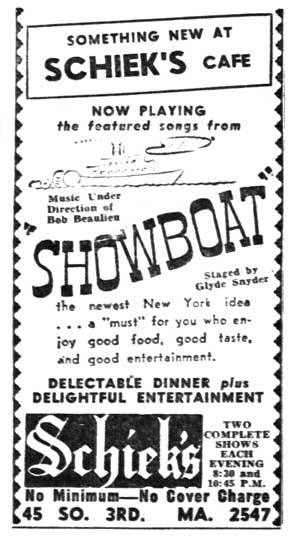
Sometime between 1952 and 1953, these “capsuled operettas” became the Singing Sextette, which did “musical comedy favorites in a most elegant old-world atmosphere.”
An anniversary article in January 1961 said that the group had never missed a night, and that 104 singers had participated since its inception.
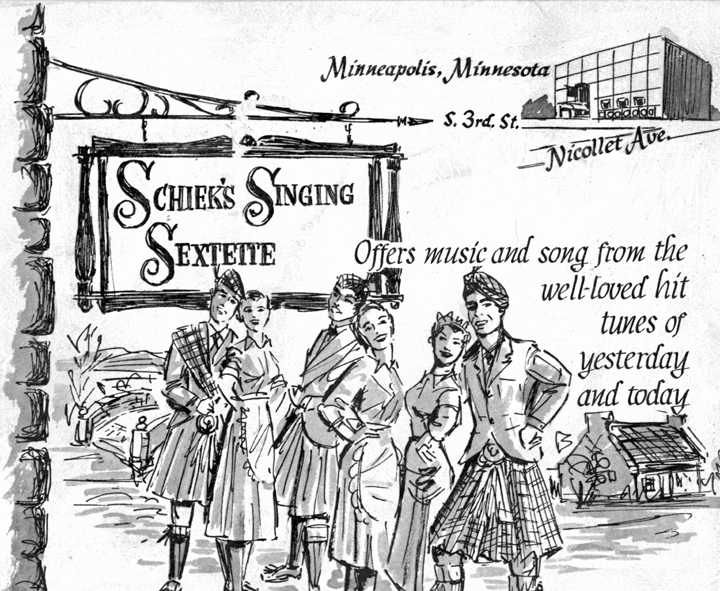
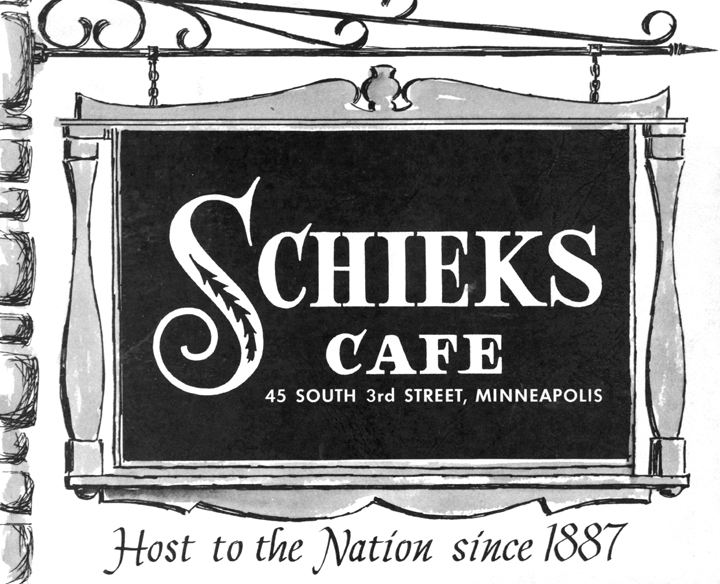
In 1963, the Restaurant was sued by Cole Porter because the Sextette was using songs from “Kiss Me Kate” without his permission.
Sign of the times:
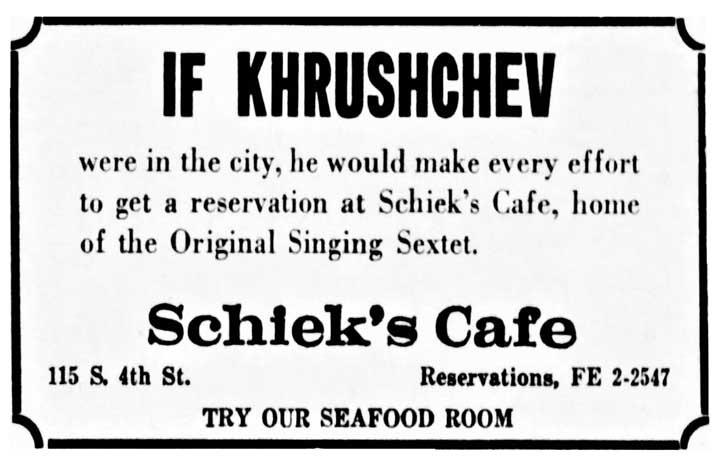

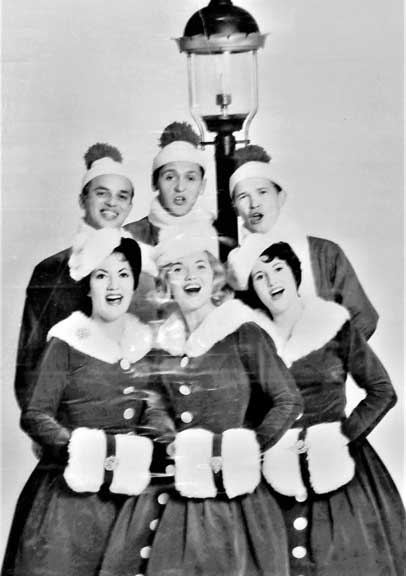
115 FOURTH STREET SOUTH
In 1959, Schiek’s was targeted for demolition because it was in the Gateway redevelopment district. At first Berger filed suit to save the building, but then withdrew his objections. It was acquired by the HRA for $167,000. The old building on Third Street was vacated in mid July, 1961, and demolished a few weeks later.
In 1961 Berger moved Schiek’s to 115 Fourth St. So., from General Mills, which had been using it for additional office space before it moved its headquarters to Golden Valley. Before that it had been the Farmers & Mechanics Bank building. Berger spent $250,000 to remodel the building, which was 3,000 sq. ft. bigger than the old building. It was a two-story building, but only the first story would be used at first. (Minneapolis Tribune, April 29, 1961)
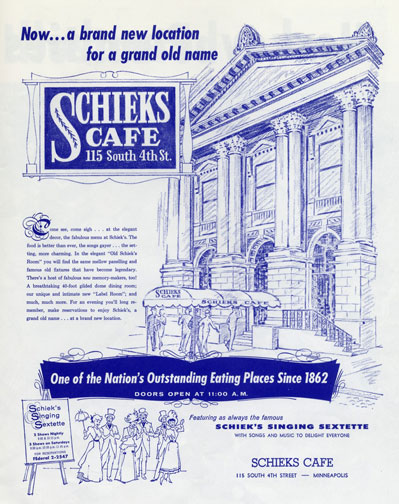
THE NEW SCHIEK’S
Will Jones gave his approval in his column in the Tribune on September 17, 1961. He provides a good description of the new place:
The old paneling and back-bar mirrors from Schiek’s have been moved (workmen merely walked up the street carrying them) and used to create on simple, high-ceilinged dining room full of the feeling of the old front dining room.
A larger room, to be called the Sextette room, is housed in what used to be the main banking floor of the old F & M bank. The Schiek’s Sextet will perform on a stage in an area that used to be a two-story-high vault. The customers will sit under a high glass dome.
The most important new item in the room will be a chandelier 10 feet in diameter, to be hung from the center of the dome. The bank’s old Italian marble walls have been shifted to accommodate new entrances, but mostly the marble has been left intact.
The cocktail bar, situated just to the left of the main entrance, will be called the Old Labels room. It will feature some old Schiek’s liquor and wine lables, found unused in a storeroom before the old place was torn down. They bear the legend Fred Schiek, 1862.
According to what we know, Schiek was a “merchant” in Lansing, Iowa in 1862 – probably a wine merchant, given his profession in Minneapolis. Some have mistakenly dated Schiek’s Cafe to this year.
Will described the lhe last major decorating problem left to be resolved: where to place Becky, a/k/a The Milkmaid. Becky was a “gilt plaster figure of a bonneted, full-skirted woman, with a wine goblet clutched in her right hand.” Becky couldn’t go back where she was over the bar or against a wall, for logistics sake. George’s deadline came and the decision was never revealed.
THE END OF SCHIEK’S
On July 31, 1971, Scheik’s was forced to close because of increasing operating losses. At the time it had 80 employees.
At some point it morphed into Schiek’s Palace Royale, a strip club.
In 2011 it was sold and renamed Downtown Cabaret.
